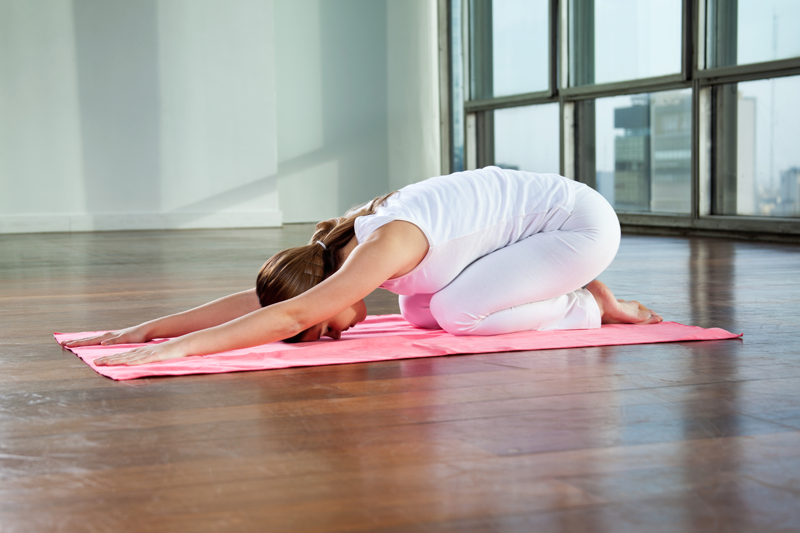The child’s pose, or Balasana, is a pose in yoga intended for resting. Your yoga instructor is likely to use this as a staging post between complex and more advanced flows. It is also a pose to return to when you are feeling fatigued by your practice and you need to restore some energy and focus. Even though this is a beginner’s pose, all abilities of yogi are dying for their teacher to suggest this pose. It is the foetal position and it is a moment of serenity and safety on your mat.
The benefits of this pose
Child’s pose relieves stress and fatigue. Its major benefit is that it promotes an easy calmness of the mind. However, it is also a useful stretch to the hips, thighs and ankles, whilst relaxing the muscles in the chest and abdomen. It also a good way to stretch the latissimus dorsi, the muscles along the spine. The more you arch your back the more you will also stretch your lats and chest muscles.
This is also a good hip opening pose and is a gentle way to bring flexibility and suppleness to the hip area – avoiding hip pain. This is why your instructor is likely to suggest child’s pose after other positions that put much strength and pressure through the hip area.
The pose is also great for the digestion. Obviously, there is the connection between the mind and the gut that cannot be underestimated. This means the calmer the mind, the calmer the stomach. However, with your belly resting against your thighs, it is a great way to massage the internal organs and help move things along the digestive tract! If you repeat this pose regularly you are literally helping to push gas through your system.
But, the main aim of child’s pose is to reconnect you with a love of resting. Yoga may be exercise but you also need to cultivate a healthy relationship with relaxation and the recharging of your batteries. So, if you struggle in meditation and focusing on conscious exploration of the breath, then the child’s pose might offer you a sanctuary from the outer world. It is also interesting to feel the breath move through the body, with the restriction to the abdomen pushing the breath into the back of the torso.
Instructions
Positioning into the child’s pose is as important as sitting in the pose itself. Take each stage is a part of the flow of this wonderful yoga pose, remaining present in the movement of your body.
- o set up for child’s pose begin on your hands and knees.
- Spread you knees wide apart but keep your big toes touching. If your hips are particularly tight, keep your thighs together at first and work towards open thighs.
- Sit up straight and push through the crown of your head.
- Exhale and bow forward. Drape over your thighs, tucking yourself into foetal position.
- Allow your forehead to rest on the mat.
- Push your arms long, extending out above your head. Your palms should face downwards onto the floor.
- If you would like to deepen the sense of relaxation, pull your arms down to your sides and against your thigh, with palms facing up. Then, relax your elbows and rest.
- To deepen the stretch, broaden your upper back and then soften, and repeat. Make sure the tension is completely missing from your shoulders and arms, and especially from the neck.
- Now hold for as long as you like… or until your yoga instructor gets particularly insistent that the class move on!
Tips
Although child’s pose is a beginner’s pose and a resting position, it is still advisable to avoid the practice if you have had a recent knee injury. If you are pregnant, you should widen the legs to allow for the stomach to push through the thighs. Make sure you speak to a medical professional if you have concerns about this pose.
Modifications and Variations
The point of child’s pose is to rest. Therefore, you need to be aware of your body and aware of where you might be holding tension or discomfort. Your aim is to release any such area of pressure on the body through small realignments of the pose. This could be as simple as smiling, which will naturally cause a slackening of the jaw and reduce tension in the face.
It might be that you find it difficult to keep your butt cheeks against your thighs. If this is the case, use a blanket or a cushion to bridge the gap. Do not force yourself into this position, it is not meant to be an action of resistance but instead an easing into the body. You can even put additional padding under the knees and the feet to make sure your body feels comfortable.
Arms up and over the head is an active version of the pose. It will open the shoulders and chest and stretch the body. This is fine if this is what your body needs. If you need something a little more restorative, then draw the arms by your sides instead.
To perfect the pose
The perfection in child’s pose is in the sense of calmness you feel in the mind. This is a moment of peace in the midst of the activity of your asana practice. Therefore, use the pose to release the worries of the day. Mindfully, set up the pose from hands and knees, to kneeling, to bowing. Be aware of each of the movements into the pose and then scan the body. Check in with yourself and see if there is somewhere that holds tension and make a concerted decision to relax. This pose is going be useful for your overall wellbeing, so do not dismiss its importance by calling it “just a beginner’s pose.”

